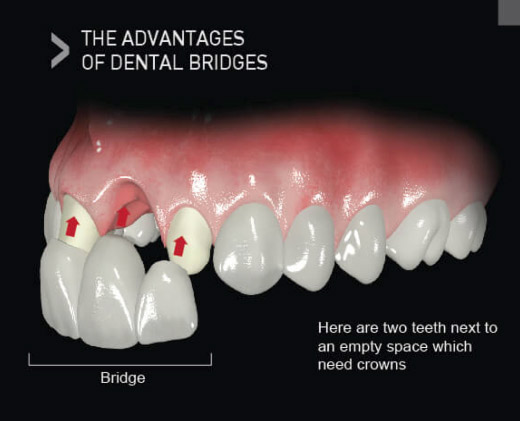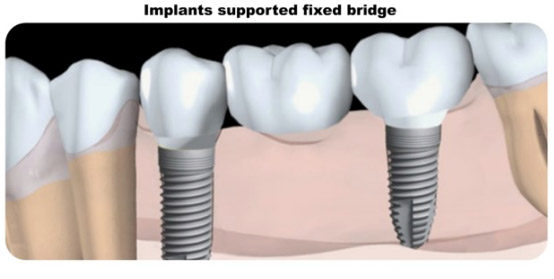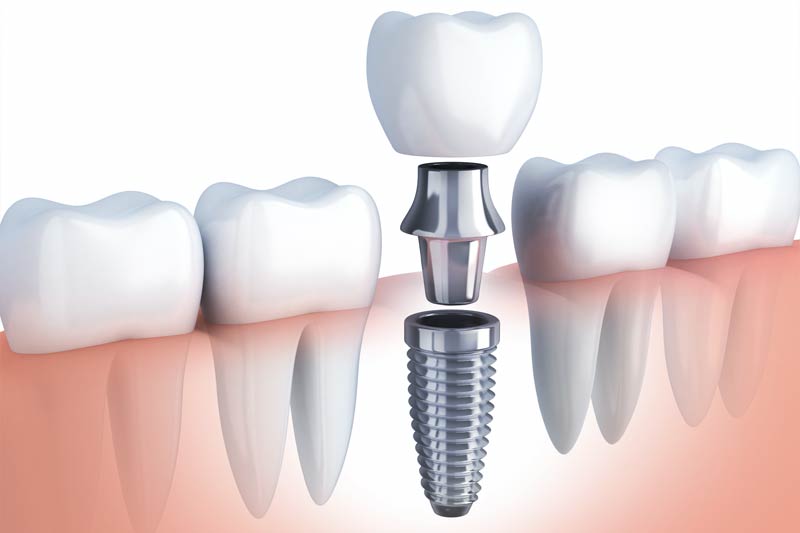Dental Bridges
A dental bridge typically consists of two or more specially fitted crowns that are placed on the abutment or anchoring teeth on either side of the space formed by your missing tooth or teeth. Fixed bridges are strong and reliable, and in most cases, they feel and look very much like natural teeth.

The pontic is the false tooth that fill gap between the abutment teeth, and they’re usually made from gold, porcelain, alloys, or a combination of materials. The anchor teeth can be your natural teeth or implants and they act as the main support for your bridge.
In order to even consider the design and construction of a dental bridge, two stable, healthy, abutment teeth must be factored into the equation. Preparing them includes contouring and reshaping them by removing enough teeth enamel to provide space for a crown to be mounted on top of the remaining tooth stub. The removal of your anchor teeth’s original shape and structure is the biggest disadvantage associated with traditional dental bridge designs. This causes the loss of significant amounts of healthy tooth tissue which can weaken the tooth, reducing its longevity potential.
In contrast, bridge restorations that are designed and supported exclusively by dental implants, offer a big plus to the adjacent natural teeth which will remain unscathed during the treatment process.

Fixed bridges are strong and reliable and in most cases they feel and look very much like natural teeth. Dental bridges can last 5 – 15 years and even longer if they remain stable, and if your personal hygiene and home care is maintained at a high level.
Disadvantages of Dental Bridges:
Please be advised, if something goes seriously awry with one of your abutment teeth, your entire dental bridge could be compromised. For example, if you develop a deep cavity, infection or periodontal (gum) disease with either supporting tooth, then you may lose the entire bridge. Therefore, the space involved, design, fit and loading capacity, along with the diagnosis of whether to do a bridge or not is critical.
A common error when making a dental bridge is their often too long. According to physical law (Ante’s Law), the longer the span of the bridge, the more force is placed on the abutment teeth. This excessive force can cause intolerable stress on the adjoining abutment teeth. Therefore, careful consideration of the biting forces, relative to your dynamic occlusion and what you eat determines what should be done.
The biggest disadvantage with dental bridges is the tooth preparation, especially if it involves young teeth with little or no restorations. We really don’t like preparing these virgin teeth to act as abutments, because studies indicate that these young teeth will most likely need root canal therapy in the future.
There are other crucial factors and important aspects that come into play and must be considered as follows prior to determining your eligibility:
- Dental bridges are usually small, lightweight, providing excellent chewing comfort
- They correct and redistribute the normal bite force, compromised by your missing teeth
- Getting used to your new dental bridge is usually easy and comfortable
- Helps maintain the shape of your face
- Controls shifting and moving of adjoining teeth
- Enhances your natural speaking and eating ability
- The longevity factor and general prognosis is good, if your hygiene and home care is maintained at a heightened level
What are the advantages of dental bridges over dental implants?
This is an important question and it should be considered whenever you’re thinking about using dental implants. Please note the examples shown below to illustrate this point.

Let’s say you have two broken down teeth next to the missing space.
This is a perfect example of why you should consider a dental bridge, as both of these teeth require crowns to protect them from future breakage disease or decay. It is mandatory for the long-term health and functionality of the teeth that they are examined thoroughly and carefully considered. We must make sure they’re stable (no movement), the roots are long enough, and you have enough teeth remaining to support this bridge.
Another strong advantage is that bridges can be done quickly. In fact, at Berkeley Lake Dental, it could be done in the same day.
There is another reason why installing dental bridges makes sense, and it’s directly related to a patient’s health condition and concerns. Some patients are not capable of undergoing implant or other larger surgical procedures due to cancer, diabetes, certain medications or autoimmune disease. Furthermore, because of your unique oral condition you may not want to engage in a complex bone reconstruction or implant surgery.
You may choose to go with a bridge if you have very little bone, which requires an extensive bone grafting procedure in order to safely support an implant.
All of this can be minimized and eliminated with careful planning and if the procedures are performed under the care of a competent and reputable surgeon.
What about implants supported bridges?
Using implants to support a bridge is an excellent way to save costs, by spacing your implants apart it will make them easier to clean and maintain. If you can’t clean around your implants well, then you risk the development of premature bone loss.


 VA Credentialed Provider
VA Credentialed Provider



